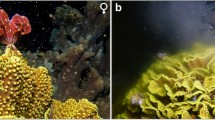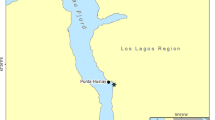Abstract
The expression of protogyny often differs among populations of a single species. The humbug damselfish, Dascyllus aruanus (Linnaeus), typically lives in spatially discrete groups of several individuals around live coral colonies and has been reported to be protogynous. The size and sexual composition of groups of this species, however, vary with the size of the coral patch or the degree of coral cover. The present study examined gonadal development and sexual pattern in a population of D. aruanus living in continuous coral-cover habitat. Fish were collected in Tumon Bay, Guam (13°31′N; 144°47′E), during a 2-week period in July and August 1996. Reflecting their distributions, small fish (n=54) were collected at depths of 1–2 m over continuous Porites spp. patches, and large fish (n=56) were collected at depths of 2–3 m over a continuous Acropora spp. patch. Gonadal development was examined histologically. Gonads of D. aruanus first developed an ovarian lumen and primary-growth stage oocytes. From this ovarian state or from more developed ovaries with cortical-alveolus stage oocytes, some gonads developed into testes through degeneration of oocytes and development of spermatogenic tissue. Developing spermatogenic tissue only occurred in gonads having pre-cortical alveolus stage oocytes, and the size of individuals with gonads of this type overlapped mainly with the size range of individuals with gonads containing only pre-vitellogenic oocytes (i.e. immature females). This suggested that functional female-to-male sex change was rare or absent in this population of D. aruanus. Moreover, the different habitat distributions of small and large fish suggest that sex determination in immature fish occurs in the absence of adults.





Similar content being viewed by others
References
Allen GR (1991) Damselfishes of the world. Mergus, Melle, Germany
Asoh K, Kasuya M (2002) Gonadal development and mode of sexuality in a coral-reef damselfish, Dascyllus trimaculatus. J Zool Lond 256:301–310
Asoh K, Yoshikawa T (2003) Gonadal development and an indication of functional protogyny in the Indian damselfish, Dascyllus carneus. J Zool Lond (in press)
Asoh K, Yoshikawa T, Kasuya M (2001) Gonadal development and non-functional protogyny in a coral reef damselfish, Dascyllus albisella Gill. J Fish Biol 58:1601–1616
Choat JH, Robertson DR (1975) Protogynous hermaphroditism in fishes of the family Scaridae. In: Reinboth R (ed) Intersexuality in the animal kingdom. Springer, Berlin Heidelberg New York, pp 263–283
Coates D (1982) Some observations on the sexuality of humbug damselfish, Dascyllus aruanus (Pisces, Pomacentridae) in the field. Z Tierpsychol 59:7–18
Cole KS (2002) Gonad morphology, sexual development, and colony composition in the obligate coral-dwelling damselfish Dascyllus aruanus. Mar Biol 140:151–163
Davies NB (1991) Mating systems. In: Krebs JR, Davies NB (eds) Behavioural ecology, an evolutionary approach, 3rd edn. Blackwell, Oxford, pp 263–294
Emlen ST, Oring LW (1977) Ecology, sexual selection, and the evolution of mating systems. Science 197:215–223
Fricke HW (1977) Community structure, social organization and ecological requirements of coral reef fish (Pomacentridae). Helgol Wiss Meeresunters 30:412–426
Fricke HW, Holzberg S (1974) Social units and hermaphroditism in a pomacentrid fish. Naturwissenschaften 61:367–368
Ghiselin MT (1969) The evolution of hermaphroditism among animals. Q Rev Biol 44:189–208
Godwin J (1995) Phylogenetic and habitat influences on mating system structure in the humbug damselfishes (Dascyllus, Pomacentridae). Bull Mar Sci 57:637–652
Gray P (1954) The microtomist's formulary and guide. Blakiston, New York
Grier HJ (1981) Cellular organization of the testis and spermatogenesis in fishes. Am Zool 21:345–357
Grier HJ (1993) Comparative organization of Sertoli cells including the Sertoli cell barrier. In: Russell LD, Griswold MD (eds) The Sertoli cell. Cache River, Clearwater, Fla., pp 703–739
Grier HJ, Linton JR, Leatherland JF, de Vlaming VL (1980) Structural evidence for two different testicular types in teleost fishes. Am J Anat 159:331–345
Holbrook SJ, Forrester GE, Schmitt RJ (2000) Spatial patterns in abundance of a damselfish reflect availability of suitable habitat. Oecologia 122:109–120
Hunter JR, Macewicz BJ (1985) Rates of atresia in the ovary of captive and wild northern anchovy, Engraulis mordax. Fish Bull (Wash DC) 83:119–136
Johnson LL, Casillas E, Myers MS, Rhodes LD, Olson OP (1991) Patterns of oocyte development and related changes in plasma 17-β estradiol, vitellogenin, and plasma chemistry in English sole Parophrys vetulus Girard. J Exp Mar Biol Ecol 152:161–185
Kock RL (1982) Patterns of abundance variation in reef fishes near an artificial reef at Guam. Environ Biol Fishes 7:121–136
MacLean SA, Morrison CM, Murchelano RA, Everline S, Evans JJ (1987) Cysts of unknown etiology in marine fishes of the Northwest Atlantic and Gulf of Mexico. Can J Zool 65:296–303
Mizushima N, Nakashima Y, Kuwamura T (2000) Semilunar spawning cycle of the humbug damselfish Dascyllus aruanus. J Ethol 18:105–108
Munday BL, Brand DG (1992) Apparently-embolic, enigmatic bodies in the gill filaments of fish. Bull Eur Assoc Fish Pathol 12:127–130
Nakamura M, Hourigan TF, Yamauchi K, Nagahama Y, Grau EG (1989) Histological and ultrastructural evidence for the role of gonadal steroid hormones in sex change in the protogynous wrasse Thalassoma duperrey. Environ Biol Fishes 24:117–136
Randall HA, Allen GR (1977) A revision of the damselfish genus Dascyllus (Pomacentridae) with the description of a new species. Rec Aust Mus 31:349–385
Reinboth R (1962) Morphologische und funktionelle Zweigeschlechtlichkeit bei marinen Teleostiern (Serranidae, Sparidae, Centracanthidae, Labridae). Zool Jahrb Abt Allg Zool Physiol Tiere 69S:405–480
Reinboth R (1970) Intersexuality in fishes. Mem Soc Endocrinol 18:515–543
Robertson DR, Warner RR (1978) Sexual patterns in the labroid fishes of the western Caribbean. II. The parrotfishes (Scaridae). Smithson Contrib Zool 255:1–26
Sadovy Y, Shapiro DY (1987) Criteria for the diagnosis of hermaphroditism in fishes. Copeia 1987:136–156
Sale PF (1970) Behaviour of the humbug fish. Aust Nat Hist 16:362–366
Sale PF (1971) Apparent effect of prior experience on a habitat preference exhibited by the reef fish, Dascyllus aruanus (Pisces: Pomacentridae). Anim Behav 19:251–256
Sale PF (1972) Influence of corals in the dispersion of the pomacentrid fish, Dascyllus aruanus. Ecology 53:741–744
Schwarz AL, Smith CL (1990) Sex change in the damselfish Dascyllus reticulatus (Richardson) (Perciformes: Pomacentridae). Bull Mar Sci 46:790–798
Selman K, Wallace RA (1989) Cellular aspects of oocyte growth in teleosts. Zool Sci 6:211–231
Shapiro DY, Rasotto MB (1993) Sex differentiation and gonadal development in the diandric, protogynous wrasse, Thalassoma bifasciatum (Pisces, Labridae). J Zool Lond 230:231–245
Shpigel M, Fishelson L (1986) Behavior and physiology of coexistence in two species of Dascyllus ( Pomacentridae, Teleostei). Environ Biol Fishes 17:253–265
Vehrencamp SL, Bradbury JW (1984) Mating systems and ecology. In: Krebs JR, Davies NB (eds) Behavioural ecology, an evolutionary approach, 2nd edn. Sinauer, Sunderland, Mass., pp 251–278
Wallace RA, Selman K (1981) Cellular and dynamic aspects of oocyte growth in teleosts. Am Zool 21:325–343
Warner RR (1975) The adaptive significance of sequential hermaphroditism in animals. Am Nat 109:61–82
Warner RR (1984) Mating behavior and hermaphroditism in coral reef fishes. Am Sci 72:128–136
Warner RR (1988a) Sex change in fishes: hypotheses, evidence, and objections. Environ Biol Fishes 22:81–90
Warner RR (1988b) Sex change and the size-advantage model. Trends Ecol Evol 3:133–136
Warner RR, Robertson DR (1978) Sexual patterns in the labroid fishes of the western Caribbean. I. The wrasses (Labridae). Smithson Contrib Zool 254:1–27
Warner RR, Robertson DR, Leigh EG Jr (1975) Sex change and sexual selection. Science 190:633–638
Acknowledgements
I am deeply indebted to the researchers and staff of the Marine Station, University of Guam, for their assistance and support in every aspect of the fieldwork. I am also grateful to R.S. Haley and G.S. Losey, Jr. for logistic and moral support, T. Yoshikawa for field assistance and preparation of picture plates, M. Kent, M.C. Rigby, and W.F. Font for information on CUE, M. Kasuya for help in histological processing, J.R. Godwin and K.S. Cole for information on gonadal development in Dascyllus spp., S. Robinow for equipment access, and the members of the Aquatic Ecology Laboratory, The Ohio State University, for their support. I thank J. Stimson, G. Steinhart, and G.M. Kilbane for reviewing an earlier draft and the revision of the manuscript, and two anonymous referees for their thorough review and valuable comments on the manuscript. The field collection and laboratory processing parts of this study were supported by a fieldwork scholarship from the East–West Center, a Hawaii Audubon Society Research Grant, a Raney Award from the American Society of Ichthyologists and Herpetologists, a Sigma Xi Grants-in-Aid of Research Award, and an International Women's Fishing Association Scholarship, and the Department of Zoology at the University of Hawaii. I was supported by a university postdoctoral fellowship from The Ohio State University during examination of the slides and writing of the manuscript. This research was approved by the Institutional Animal Care and Use Committee of the University of Hawaii.
Author information
Authors and Affiliations
Corresponding author
Additional information
Communicated by J.P. Grassle, New Brunswick
Rights and permissions
About this article
Cite this article
Asoh, K. Gonadal development and infrequent sex change in a population of the humbug damselfish, Dascyllus aruanus, in continuous coral-cover habitat. Marine Biology 142, 1207–1218 (2003). https://doi.org/10.1007/s00227-003-1051-6
Received:
Accepted:
Published:
Issue Date:
DOI: https://doi.org/10.1007/s00227-003-1051-6




